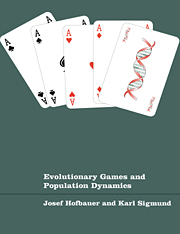Book contents
- Frontmatter
- Contents
- Preface
- Introduction for game theorists
- Introduction for biologists
- About this book
- Part one Dynamical Systems and Lotka–Volterra Equations
- Part two Game Dynamics and Replicator Equations
- 6 Evolutionarily stable strategies
- 7 Replicator dynamics
- 8 Other game dynamics
- 9 Adaptive dynamics
- 10 Asymmetric games
- 11 More on bimatrix games
- Part three Permanence and Stability
- Part four Population Genetics and Game Dynamics
- References
- Index
6 - Evolutionarily stable strategies
Published online by Cambridge University Press: 05 June 2012
- Frontmatter
- Contents
- Preface
- Introduction for game theorists
- Introduction for biologists
- About this book
- Part one Dynamical Systems and Lotka–Volterra Equations
- Part two Game Dynamics and Replicator Equations
- 6 Evolutionarily stable strategies
- 7 Replicator dynamics
- 8 Other game dynamics
- 9 Adaptive dynamics
- 10 Asymmetric games
- 11 More on bimatrix games
- Part three Permanence and Stability
- Part four Population Genetics and Game Dynamics
- References
- Index
Summary
Motivated by some biological examples, we introduce the game-theoretical notions of Nash equilibrium and evolutionarily stable strategy. An evolutionarily stable population is proof against invading minorities.
Hawks and doves
A long-standing theme of ethology is the prevalence of conventional fights. Conflicts among animals (especially within heavily armed species) are often settled by displays rather than all-out fighting. A whole gamut of threatening signals and harmless assessments of strength serves to settle contests for food, territory and mates, so that escalated fights leading to injury or death are relatively rare. Stags, for example, engage in roaring matches, starting slowly at first and increasing the rate. If the intruder does not quit at that stage, this is followed by a parallel walk. This in turn may end with a retreat, or with a direct contest in strength: the stags clash head on, as if on a cue, interlock antlers and push against each other. If one stag turns earlier, and faces the flank of his opponent with the lethal points of his antlers, he halts his attack and resumes the parallel walk. Only a few contests lead to serious injuries.
Such conventional fights have been compared with boxing tournaments, and the restrained nature of animal aggression has often been stressed. It is obviously all to the good of the species, but needs an explanation from an evolutionary point of view.
Information
- Type
- Chapter
- Information
- Evolutionary Games and Population Dynamics , pp. 57 - 66Publisher: Cambridge University PressPrint publication year: 1998
